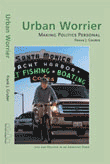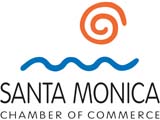| The Lookout columns | What I Say |
| Archive | Columns | Special Reports | The City | Commerce | Links | About | Contacts |
| About Frank | Archive | Email Frank |  |
 BUILDING A THRIVING COMMUNITY SINDE 1925 |
 Live in Downtown Sata Monica |
|
 |
Read
Frank Gruber's Political Analysis in "What I Say" every Monday |
|||||
| Good Problem to Have | ||
|
By Frank Gruber November 22, 2010 -- The Traffic Management Division of Santa Monica’s planning department, after discussions with the traffic subcommittee of the board of the Bayside District, is implementing two changes -- purportedly on a temporary, “test” basis -- to downtown traffic patterns over the holidays. The intersection at Second and Santa Monica Boulevard will become a “scrambled intersection” for pedestrians, meaning that there will be a pedestrians-only phase in the traffic signals when walkers can cross the intersection diagonally. The other change is that the City will create another westbound traffic lane by removing parking (including the taxi rank) from the north side of Santa Monica Boulevard from Fourth Street west to Ocean Avenue. According to the City’s traffic engineer, Sam Morrissey, the traffic division is trying these changes because measures are needed to “improve flow through downtown.” This premise is false. There is no need to improve “flow” downtown for motorists in cars. True, traffic backs up in downtown Santa Monica. But downtown is a destination. As a destination, downtown’s traffic situation is as it should be: crowded streets, slowly moving cars, more pedestrians than motorists at nearly all intersections nearly all the time. This is called success, and towns and cities all over America would like to have this problem. Back in the ’50s and ’60s downtowns all over America were killed by efforts to improve the flow through them, with freeways, street widenings, one-way streets, and the elimination of street parking. After 20 years of this success in downtown Santa Monica where traffic is continually congested, you would think that the traffic subcommittee of the Bayside board would understand the dynamic. Customers come here because they enjoy being pedestrians. Those who drive here, choose to do so despite the traffic. They could take a freeway or a boulevard to a mall, but they don’t. And residents know that if you’re driving into downtown from the east, you take Arizona or Broadway. Motorists are not stuck at the corner of Fourth and Santa Monica because they’re “flowing” any place farther away than Second Street or Ocean Avenue, and then what’s the point of getting them there a few minutes faster? After they park, they get out of their cars and become pedestrians. Their next unhappy moment comes later, when after spending a few hours spending money it takes them half an hour to exit a parking structure from the fifth floor. Downtown Santa Monica has per-square-foot retail sales among the highest anywhere. What was the only unsuccessful part of downtown? The old enclosed Santa Monica Place -- the only part of downtown that was suburban. What’s the point of making traffic flow better downtown? To attract even more drivers? What for? Memo to Bayside Board of Directors: tell the traffic subcommittee that pedestrians come first. What’s also disturbing about these changes is that they came out of the blue, ignoring any semblance of public process, while playing around with a traffic pattern that was established in the ’90s after a long and very public process. Back then, in response to complaints from merchants about one-way streets (Broadway and Fifth Street were one-way) and -- get this -- too many bus riders crowding the (then) narrow sidewalks of Santa Monica Boulevard, the City initiated a review of the street network downtown. The City hired planner Boris Dramov and created the “Design Working Group,” which consisted of three city council members and two planning commissioners to oversee what became a long process. (Full disclosure: I was one of the planning commissioners.) After all was said and done and analyzed, the City made the one-way streets two-way, widened sidewalks, and reduced traffic lanes to provide for the two bus lanes and street parking. The plans were controversial, and had to survive a court challenge at the last minute. (I wrote about this process in more detail in my column at the time of the lawsuit: Downtown Traffic, February 9, 2001.) The changes the City made downtown were a rousing success – even if only based on the continued investment downtown attracts -- and presaged the hottest trend in urban traffic management today, which is to reduce lanes for private cars. These ideas have been most stunningly implemented in New York City, where traffic lanes have been removed from, among many other places, Times Square, to create new plazas.
But enough history. What about the two changes the traffic division is making. Well, the scrambled intersection has promise. We all have seen them in Westwood and Beverly Hills, and they seem to work. From a pedestrian’s perspective, the good is that you can walk across the intersection diagonally; the tradeoff is that you can’t cross in any direction when motorists have green lights, so that they can make their turns. If the traffic engineers wanted to test something interesting, however, they should try turning a signalized intersection into one with the equivalent of a four-way stop signs, by making all the lights flash red. This has been done in Europe, and counter-intuitively traffic in many circumstances becomes less backed up. It turns out that when motorists go cautiously, they make way for each other and for pedestrians. Traffic moves slowly, but it doesn’t back up so much. The intersection becomes more efficient because it’s being used all the time, as opposed to what happens with traffic signals, when frequently for a good part of the cycle cars are no longer going through the green, yet cars in the other direction are still waiting for the red to change. As for the other change, removing the parking and taxis from Santa Monica Boulevard is a bad idea even if traffic moves faster (or in fact because traffic may move faster). The parked cars and the taxis provide a buffer between the pedestrians on the sidewalk and the traffic. Adding a lane of traffic bearing down on the intersection where the Promenade crosses Santa Monica Boulevard, where hundreds of pedestrians cross every few minutes, is a mistake. As for the taxis, they provide a service for people who choose not to drive cars downtown -- our traffic-reduction heroes. It’s not that nothing can be done downtown to make circulation better for both pedestrians and motorists, not to mention transit users. The worst problem is motorists who block intersections, but adding another travel lane on Santa Monica Boulevard will probably make that worse. My office is on Fourth Street near Santa Monica Boulevard, and I often get a coffee at Leonidas and step out to the corner and watch the traffic while I drink it. Motorists frequently enter the intersection without having a way out and block it when the light changes. This blocks Fourth Street, which is an important route for buses. But I’ve never seen a cop give out a ticket, even though one inconsiderate driver can block a couple of dozen cars and buses carrying a few score passengers. But then for reasons I don’t know the Santa Monica police have always preferred to direct traffic downtown than give tickets to clueless drivers. (See “Don’t Spend it All in One Place, June 16 2003”) The fact is that until these changes came up, the City was already doing good things to reduce the number of vehicles downtown. It has increased parking charges both in the structures and at meters, and is in the process of reducing the number of taxis, which add significantly to the number of cars cruising downtown streets. If it is serious about congestion, the City should continue to discourage driving, rather than create the illusion that traffic might get better. Frank J. Gruber is the author of Urban Worrier: Making Politics Personal, available at Hennessey + Ingalls and Angel City books in Santa Monica, at City Image Press, and on amazon.com. |
| If readers want to write the editor about this column, send your emails to The Lookout at mail@surfsantamonica.com . If readers want to write Frank Gruber, email frank@frankjgruber.net The views expressed in this column are those of Frank Gruber and do not necessarily reflect the opinions of The Lookout. |
| Copyright 1999-2010 surfsantamonica.com. All Rights Reserved. |